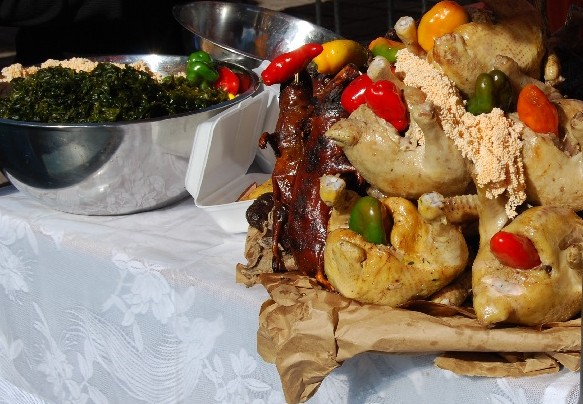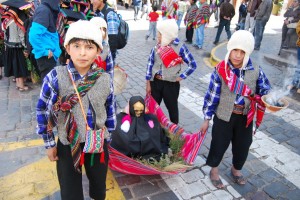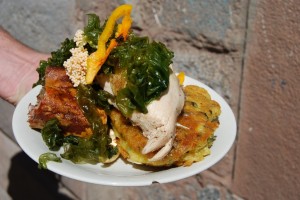Cuzco’s Festival Food for the Solstice

Cold and abundant. That is chiriuchu, the dish that is served beginning today and for the next week in Cuzco as it celebrates the Feast of Corpus Christi. It is a complex dish, bringing together in a towering mountain parched corn, different meats, and food from watery realms. And, over the next week almost everyone will eat this fascinating dish that is served cold, just like the season.
This morning vendors will begin selling chiriuchu (cheery-óoh-chew) on the esplanade, the plaza, at the side of the Church of San Francisco, right by the old arch that marked an entrance into colonial Cuzco from Cuntisuyo, the southern coast and one of the Inca Empires four quarters.
This will take place about the same time that the saints from Cuzco’s historic neighborhoods will process around the plaza along with the Holy Sacrament. They came to the Cathedral last night with accompanying dance troupes and bands to spend a week while the city parties.
Corpus Christi itself is an enormous celebration that involves everyone in the city. Established by the Spanish to celebrate what they hoped was the complete conquest of indigenous Cuzco, body and soul, nevertheless the feast quickly became a way for the people of Cuzco to continue celebrating the great Inca solstice feast of Inti Raymi.
In 1944 Cuzco’s Incanizing elites re-created Inti Raymi as a massive pageant. This Friday, when much of the Andes celebrates the night of St. John, the coldest of the year, with bonfires to lighten the night and bring heat to the land, Cuzco will be occupied with this performance.


It is unusual for these two, historically different, reformulations of the great Inca Inti Raymi to come together back to back like they do this year. Inevitably, their juxtaposition shows the complexity of this city that once was the capital of the greatest empire in South America and one of the greatest in the world. As a result Cuzco pulses with sound and movement. So much is going on.
The city has already lived almost a week in which people from almost every organization would dress in one recreation or another of “indigenous” clothes to parade around the main square while dancing one or another native dance. And, it has at least another week to go.
The celebration of what is called the Days of Cuzco began with small children and their schools and ended yesterday in a massive civic parade, a time when it seemed the whole population of Cuzco was either watching or dancing in swirls of color before ending in one square or another and sharing beers.

They drank beneath banners from the municipality urging Cuzco’s populace and visitors to celebrate the city’s heritage but to not drink openly in its public spaces. Once again, the city’s Andean past overwhelmed its administrator’s efforts to reformulate and modernize. Beer seemed everywhere.
Now begins Corpus Christi when the Saints will also congregate in the city’s center, bringing their followers with them. This time, though, it will not just be people from the city alone but from a much larger region. For eight days people will celebrate with drink, dance, and lots of food. And, in the middle of this the Inti Raymi pageant will also take place.

Abundance overwhelms everything during this time when the night is at its longest and the daylight feels thin and chill.
Chiriuchu is a symbolic dish of abundance. Rosario Olivas Weston (p 43) describes it as follows.
The typical dish of Corpus Christi is the chiri-uchu which means “cold spice”. It is also known by the name of llachuay uchu. It consists of a piece of cheese along with cancha [parched corn], corn omelet, boiled chicken, roasted guinea pig, sausage, hot dog, cau cau (fish eggs) dried meat, a bit of sea weed, and the huaraca, guinea pig blood.
This dish is eaten with the hands, mixing mouthfuls of one or another ingredient. At the end is drunk a glass of aguardiente or compuesto (an infusion of herbs with a squirt of distilled cane alcohol) to aid digestion. The sea weed and fish eggs come from the coast of Arequipa, the cheese from Puno, and the other products come from different parts of Cuzco. This reminds us of the banquets in Inca times, when each person would bring their own food and they would share with each others such that everyone would eat food from different zones.
The dish towers on the plate like the geography of Cuzco, a mountain of diverse ingredients in layers. Although there is not a strict order, usually the parched corn — the product of valley floors and lowlands — is placed on the bottom. On it is layered the cheese, the omelet, boiled chicken, sausages, dried meat, roasted guinea pig, the sea weed and fish eggs. The dish is often topped with a slice of red rocoto, or hot pepper.

Not only is the dish the image of a mountain with its people — often of different origins — living on different levels with different ecologies and products, it is also the consumption of symbols of the prosperous south, the high plateau around Lake Titicaca and the southern coast. As a result, it also brings together the two big bodies of water that frame the mountains, the enormous and powerful Lake Titicaca and the Pacific Ocean.
The dish is eaten cold. While abundant and representing the different parts of Cuzco, and the areas to its south, joined together in the image of a mountain, its coldness stands in contrast to the massive procession taking place on the main square.
There, a procession of the saints that represent all the city’s neighborhoods is led by the image of the Holy Host. To indigenous Peruvians this seemed the sun. Of course, Catholics did borrow the image of the host from ancient Roman solar imagery.
So, in one way, the cold plate of abundance lays background for the sun and the city’s saints to process around the main square. Or, in the preferred Catholic interpretation the plate lays background for the symbolized body of Christ to move around the town with the heat of its holiness.

In any case, the cold is a representation of the land and people needing more light and heat, during this time when the days are at their shortest and cold keeps coming with more and more intensity.
Called an uchu, which literally means hot pepper in Quechua, it is something seasoned and hence a dish. The word uchu served to refer to dishes of flavored food, not necessarily to spicy food as one might think in English given that the word also meant hot pepper.
For us, though, there is another meaning here. Eating a meal together, sharing food, is similar to Christian notions of sacrament and prayer. As a result, it is significant that this is the feast of the holy host, the great element of Christianity’s collective meal when the most sacred of Christian symbols is taken into the body.
In Andean thought, the collective eating is also sharing the food with the earth and the sun, as a means of strengthening both during this time of darkness and cold, as is the massive consumption of alcohol, whether beer, aguardiente, or chicha.
The sun will grow stronger and days grow longer. In a couple of months people will begin to worry about the coming of the rains to wet the earth and make it grow. The sea weed and fish eggs, generally on the top of the chiriuchu help call them, so that after this time when the land is brown and cold, it will warm, become damp, and burst with abundant growth. Again there will be food.
CORRECTION: Today is the entrance of the Saints to the Cathedral. They are gathering at the church of San Pedro, by the market of the same name, to make their grand procession to the Cathedral. Tomorrow is the procession of the Holy Sacrament and Saints around the plaza. I regret the error of locating that for today.





What intriguing piece
An all around amazingly written post!!